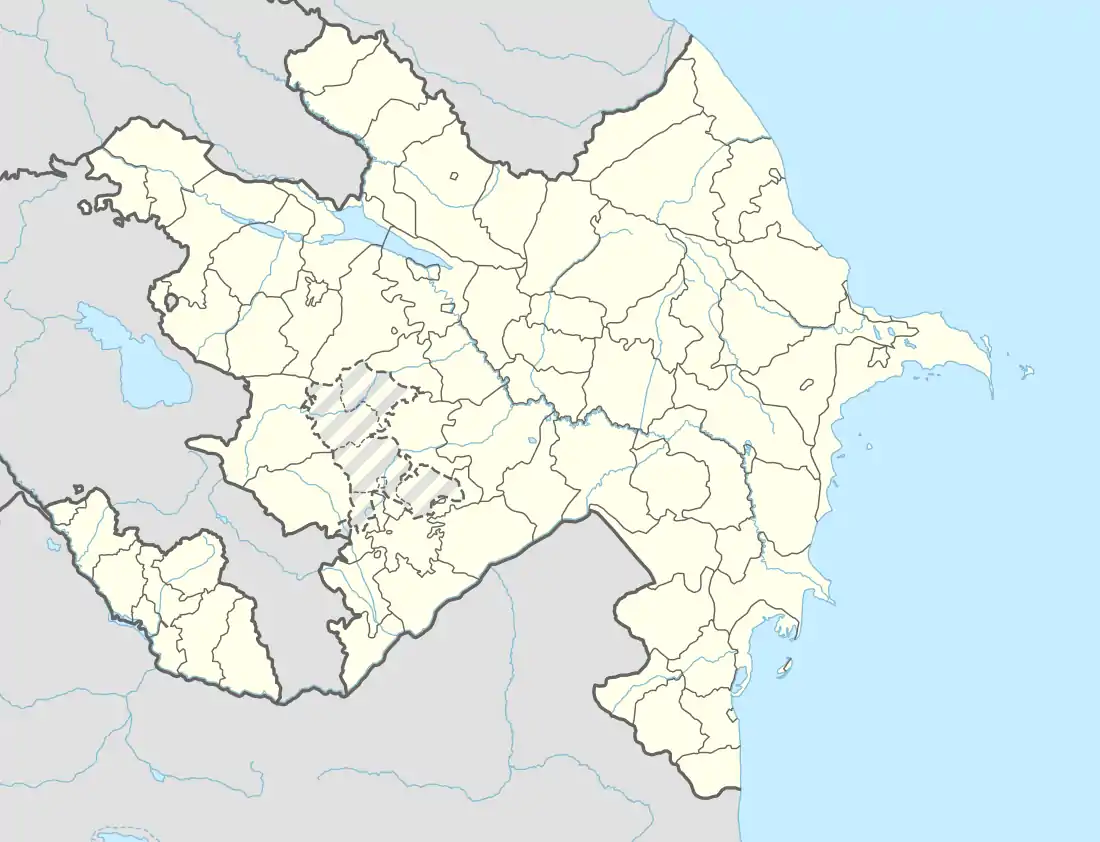Shikharkh, Azerbaijan
Shikharkh (Azerbaijani: Şıxarx) or Maragha (Armenian: Մարաղա; Azerbaijani: Marağa), formerly known as Leninavan (between 1954-1992) is a town in the Tartar District of Azerbaijan. The town had an ethnic Armenian-majority population in 1989, which was a village by then.[1] It is now a town inhabited by the Azerbaijani refugees from Nagorno-Karabakh and the surrounding occupied territories.[2]
Şıxarx
Մարաղա • Maragha | |
|---|---|
 Şıxarx | |
| Coordinates: 40°19′48″N 46°52′48″E | |
| Country | |
| District | Tartar |
| Elevation | 15 m (49 ft) |
| Time zone | UTC+4 (AZT) |
| • Summer (DST) | UTC+5 (AZT) |
History
First Nagorno-Karabakh War
On 10 April 1992, during the First Nagorno-Karabakh War, the village, known as Leninavan by then, was the scene of a massacre of ethnic Armenians by Azerbaijani forces,[3] which has been described as an act of revenge after the Khojaly Massacre.[4]
Interwar period
The Azerbaijani government built a town composed of dozens of apartment buildings[5] in the former village for the Azerbaijani refugees from Nagorno-Karabakh and the surrounding Armenian-occupied territories. They were moved to there from tent settlements around the country.[2]
Second Nagorno-Karabakh War
During the Second Nagorno-Karabakh War, the site was a scene to constant and indiscriminate bombardment by the Armenian Armed Forces and the self-proclaimed Artsakh Defence Army with artillery, missiles, and cluster munitions throughout the 2020 Nagorno-Karabakh war, which continued for several months. The Armenian bombardment heavily damaged the town,[6] causing many civilian deaths.[7]
Amnesty International, on 14 January 2021, reported that in Shikharkh, out of 34 apartment buildings built in the town, at least 25 of them were struck, the roofs of eight buildings were destroyed, and hundreds of other apartments and administrative buildings sustained varying degrees of damage.[5]
References
Shikharkh, Azerbaijan at GEOnet Names Server
- Андрей Зубов. "Андрей Зубов. Карабах: Мир и Война". drugoivzgliad.com.
- Ismayilov, Rovshan (5 July 2007). "Azerbaijan: Life on the Frontlines". Eurasianet. Retrieved 11 December 2020 – via ReliefWeb.
- De Waal, Thomas. Black Garden: Armenia and Azerbaijan Through Peace and War. New York: New York University Press, 2003, p. 176.
- Melkonian, Markar (2005). My Brother's Road: An American's Fateful Journey to Armenia. I.B.Tauris. pp. 213–214. ISBN 1-85043-635-5.
Khojalu had been a strategic goal, but it had also been an act of revenge. Monte knew that enemy fighters would retaliate in kind, and sure enough, when Azeri forces overran the Armenian village of Maragha the next month, they slashed and burned Armenian captives.
- "IN THE LINE OF FIRE". Amnesty International. 14 January 2021. Archived from the original (PDF) on 15 January 2021. Retrieved 15 January 2021 – via ReliefWeb.
- "Armenia: Unlawful Rocket, Missile Strikes on Azerbaijan". Human Rights Watch. 11 December 2020. Retrieved 11 December 2020.
- "Azerbaijan reveals details of casualties, injuries in Tartar inflicted by Armenian troops". MENAFN. 29 October 2020. Retrieved 13 December 2020.
.svg.png.webp)
